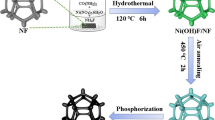Abstract
Hydrogen evolution property is an important factor to regulate the surface structure of the electrodeposited Ni film. In this work, the dependence of current density on hydrogen evolution property is researched. The structure evolution mechanism of the Ni film depending on current density is analyzed in terms of the hydrogen evolution characteristic. It is found that the surface structure of the Ni film from compact to porous structure could be achieved by adjusting the electrodeposition current density. At low current density (less than 0.07 A cm−2), the current efficient of hydrogen evolution is very weak. Ni electrodeposition is the main reaction, so compact Ni film is formed. At high current density (higher than 0.3 A cm−2), hydrogen evolution reaction is enhanced with the increase of current density. At this time, there are plenty of bubbles which can act as templates. As a result, porous Ni film is electrodeposited. However, when the current density is lower than 0.7 A cm−2, dish-like pore with large diameter is formed due to the large break-off diameter and the long resident time of the hydrogen bubble. And honeycomb-like pore with small diameter is formed at current density larger than 1 A cm−2, because of reduced break-off diameter and resident time of the hydrogen bubble. Porous film with uniform structure is electrodeposited at 1 A cm−2, which possesses the higher catalytic activity for hydrogen evolution.








Similar content being viewed by others
References
M. Fang, G. Dong, R. Wei, and J. Ho: Adv. Energy Mater., 2017, vol. 7, art. no. 1700559.
M. Wang, X. Yu, Z. Wang, X. Gong, and Z. Guo: J. Mater. Chem. A, 2017, vol. 5, pp. 9488-9513.
X. Xing, S. Cherevko, and C.H. Chung: Mater. Chem. Phys., 2011, vol. 126, pp. 36-40.
B.J. Plowman, L.A. Jones, and S.K. Bhargava: Chem. Commun. 2015, vol. 51 pp. 4331-4346.
S. Cherevko, and C.H. Chung: Electrochem. Commun., 2011, vol. 13, pp. 16-19.
S. Cherevko, X. Xing, and C.H. Chung: Appl. Surf. Sci., 2011, vol. 257, pp. 8054-8061.
S. Cherevko, and C.H. Chung: Electrochim. Acta, 2010, vol. 55, pp. 6383-6390.
S. Cherevko, N. Kulyk, and C.H. Chung: Langmuir, 2012, vol. 28, pp. 3306–3315.
E.P. Barbano, I.A. Carlos, and E. Vallés: Surf. Coat.Technol., 2017, vol. 324, pp. 80-84.
X. Yu, M. Wang, Z. Wang, X. Gong, and Z. Guo: J. Phys. Chem. C, 2017, vol. 121, pp. 16792-16802.
X. Yu, M. Wang, Z. Wang, X. Gong, and Z. Guo: Appl. Surf. Sci., 2016, vol. 360, pp. 502-509.
W. Tsai, P. Hsu, Y. Hwu, C. Chen, L. Chang, J. Je, H. Lin, A. Groso, and G. Margaritondo: Nature, 2002, vol. 417, pp. 139-139.
N.D. Nikolic, K.I. Popov, L.J. Pavlovic, and M.G. Pavlovic: Surf. Coat.Technol., 2006, vol. 201, pp. 560-566.
H. Zhang, Y. Ye, R. Shen, C. Ru, and Y. Hu: J. Electrochem. Soc., 2013, vol. 160, pp. D441-D445.
H.C. Shin, and M.L. Liu: Chem. Mater., 2004, vol. 16, pp. 5460-5464.
R. Kim, D. Han, D. Nam, J. Kim, and H. Kwon: Jpn. J. Microbiol., 2010, vol. 1, pp. 1-9.
L. Rafailović, C. Gammer, C. Rentenberger, C. Kleber, A. Whitehead, B. Gollas, and H. Karnthaler: Phys. Chem. Chem. Phys. 2012, vol. 14, pp. 972-980.
C. Srivastava, S.K. Ghosha, S. Rajak, A.K. Sahu, R. Tewari, V. Kaina, and G.K. Dey: Surf. Coat.Technol., 2017, vol. 313, pp. 8-16.
I. Matsui, N. Omura, T. Yamamoto, and Y. Takigawa: Surf. Coat.Technol., 2018, vol. 337, pp. 411-417.
M. Wang, Z. Wang, X. Yu, X. Gong, and Z. Guo: Int. J. Hydrogen Energy, 2015, vol. 40, pp. 2173-2181.
C. Cheng, T. Yeh, M. Tsai, H. Chou, H.Wu, and C. Hsieh: Surf. Coat.Technol., 2017, vol. 324, pp. 80-84.
Z. Q. Cui, Principles of Metallography and heat treatment, Harbin Institute of Technology Press, Harbin, 2008.
I. Najdovski, and A. O’Mullane: Electroanal. Chem., 2014, vol. 722-723, pp. 95-101.
X. Chen, L. Kong, D. Dong, G. Yang, L. Yu, J. Chenand, and P. Zhang: J. Phys. Chem. C, 2009, vol. 113, pp. 5396-5401.
H.Y. Jiang, Metallurgical Electrochemistry, Metallurgical Industry Press, Beijing, 1983.
X. Yu, M. Wang, Z. Wang, X. Gong, and Z. Guo: Electrochim. Acta, 2016, vol. 211, pp. 900-910.
C. Gonzalez-Buch, I. Herraiz-Cardona, E. Ortega, J. Garcia-Anton, and V. Perez-Herranz: Int. J. Hydrogen Energy, 2013, vol. 38, pp. 10157-10169.
B. Hirschorn, M. E. Orazem, B. Tribollet, V. Vivier, I. Frateur, and M. Musiani: Electrochim. Acta, 2010, vol. 55, pp. 6218-6227.
Acknowledgments
This work is supported by the Natural Science Foundation of China (51804023) and Fundamental Research Funds for the Central Universities (FRF-TP-18-007A1).
Author information
Authors and Affiliations
Corresponding author
Additional information
Manuscript submitted November 2, 2018.
Rights and permissions
About this article
Cite this article
Yu, X., Yuan, Z. The Structure Evolution Mechanism of Ni Films Depending on Hydrogen Evolution Property During Electrodeposition Process. Metall Mater Trans B 50, 587–594 (2019). https://doi.org/10.1007/s11663-019-01512-4
Received:
Published:
Issue Date:
DOI: https://doi.org/10.1007/s11663-019-01512-4




